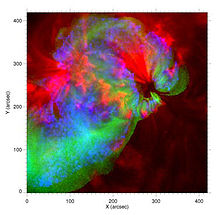
A nanoflare is a very small episodic heating event which happens in the corona, the external atmosphere of the Sun.
The hypothesis of small impulsive heating events as a possible explanation of the coronal heating was first suggested by Thomas Gold[2] and then later developed and dubbed "nanoflares" by Eugene Parker.[3][4]
According to Parker a nanoflare arises from an event of magnetic reconnection which converts the energy stored in the solar magnetic field into the motion of the plasma. The plasma motion (thought as fluid motion) occurs at length-scales so small that it is soon damped by the turbulence and then by the viscosity. In such a way the energy is quickly converted into heat, and conducted by the free electrons along the magnetic field lines closer to the place where the nanoflare switches on. In order to heat a region of very high X-ray emission, over an area of one square arcsec on the Sun, a nanoflare of 1017 J should happen every 20 seconds, and 1000 nanoflares per second should occur in a large active region of 105 x 105 km2. On the basis of this theory, the emission coming from a big flare could be caused by a series of nanoflares, not observable individually.
The nanoflare model has long suffered from a lack of observational evidence. Simulations predict that nanoflares produce a faint, hot (~10 MK) component of the emission measure.[5] Current instruments, such as the Extreme-Ultraviolet Imaging Spectrometer on board Hinode, are not adequately sensitive to the range in which this faint emission occurs, making a confident detection impossible.[6] Recent evidence from the EUNIS sounding rocket has provided some spectral evidence for non-flaring plasma at temperatures near 9 MK in active region cores.[7]
- ^ "NASA - Tiny Flares Responsible for Outsized Heat of Sun's Atmosphere". Retrieved 23 September 2014.
- ^ Cargill, P. J.; Warren, H. P.; Bradshaw, S. J. (2015-05-28). "Modelling nanoflares in active regions and implications for coronal heating mechanisms". Philosophical Transactions of the Royal Society A: Mathematical, Physical and Engineering Sciences. 373 (2042). The original reference to Gold's discussion is not available online, but is the second reference made within the paper itself: 20140260. Bibcode:2015RSPTA.37340260C. doi:10.1098/rsta.2014.0260. PMC 4410551. PMID 25897093.
- ^ Parker, Eugene N. (1972). "Topological Dissipation and the Small-scale Fields in Turbulent Gases". The Astrophysical Journal. 174: 499. Bibcode:1972ApJ...174..499P. doi:10.1086/151512.
- ^ Parker, E. N. (July 1988). "Nanoflares and the solar X-ray corona". The Astrophysical Journal. 330: 474. doi:10.1086/166485. ISSN 0004-637X.
- ^ Klimchuk, Jim (2006). "On Solving the Coronal Heating Problem". Solar Physics. 234 (1): 41–77. arXiv:astro-ph/0511841. Bibcode:2006SoPh..234...41K. doi:10.1007/s11207-006-0055-z. S2CID 119329755.
- ^ Winebarger, Amy; Warren, Harry; Schmelz, Joan; Cirtain, Jonathan; Mulu-Moor, Fana; Golub, Leon; Kobayashi, Ken (2012). "Defining the Blind-Spot of Hinode EIS and XRT Temperature Measurements". The Astrophysical Journal Letters. 746 (2): L17. Bibcode:2012ApJ...746L..17W. doi:10.1088/2041-8205/746/2/L17. S2CID 120517153.
- ^ Brosius, Jeffrey; Adrian, Daw; Rabin, D.M. (2014). "Pervasive Faint Fe XIX Emission from a Solar Active Region Observed with EUNIS-13: Evidence for Nanoflare Heating". The Astrophysical Journal. 790 (2): 112. Bibcode:2014ApJ...790..112B. doi:10.1088/0004-637X/790/2/112.